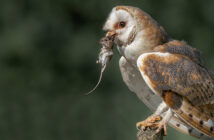We now know what has to be done to implement the stewardship that HSE has asked the industry to deliver to safeguard the future of Second Generation Anticoagulant Rodenticides (SGARs). Its straightforward, follow the new CRRU Code of Best Practice & Guidance for Rodent Control and the Safe Use of Rodenticides.
The 24-page Code, published in time for PestEx, is written in plain English and must become the Bible for pest professionals, gamekeepers and farmers. Yes, for the first time all ‘professional’ users have the same code to follow.
There are plenty of easy ways to obtain your copy – download it here and now, visit the CRRU stand at PestEx and use your SmartPhone and the QR code on the stand, pick-up a hard copy at PestEx or visit the CRRU website to request a hard copy. Please read it and follow it.
The new Code is based on two Health & Safety Executive (HSE) Information sheets published in the late 1990s – one for public health pest control and one for agriculture. As Dr Alan Buckle chairman of the Campaign for Responsible Rodenticide Use (CRRU) explains: “Some of the information is taken ‘word for word’ from these documents but of course, in the meantime, much has changed and this is reflected in the new Code.”
So what’s new in this Code?
First of all there is much more emphasis on non-rodenticide methods of rodent control and a requirement to consider these before using any rodenticide. The idea that a pest professional can go to a rodent infested site with plenty of harbourage and food and just put down a load of bait is completely unacceptable. Professional pest controllers wouldn’t do that anyhow, but let’s face it sometimes there is a temptation to cut corners. Rodenticide should never be used as a first resort, always consider all the options and be prepared to have those difficult conversations with customers about what they need to do to tackle harbourages and food supply problems.
Concept of risk hierarchy
The second big change is the introduction of the concept of risk hierarchy. If you’ve ever had to do a COSHH assessment then this won’t be entirely new to you. When it comes to rodent control it means looking at the relative risks to the environment and wildlife of trapping, gassing and using rodenticides. And each and every situation will be different. As a professional you must use your knowledge and skill to choose the option that poses the lowest risk environmentally, but that will still be effective.
Then there’s the thorny issue of perpetual perimeter baiting. Dr Buckle is clear that the bait box filling business model should never be used. There will be occasions, however, when recurring infestations mean long-term baiting is required, but these will very much be the exception to the rule.
Commenting on the launch of the new Code BPCA’s Simon Forrester endorsed the need to move away from the ‘ring of steel’ approach, switching instead to integrated pest management and an understanding of the risk hierarchy.
NPTA’s Iain Turner told us that his association has already decided that following the Code will be a basic membership requirement. “Members will have to sign to say that they have read, understood and will work within the CRRU Code.”
And finally for now, it is interesting to note the organisations listed on page two of the Code as helping in the development of the document. In particular, it is pleasing to see the Barn Owl Trust and the various gamekeeping organisations taking part and supporting the document. One group is conspicuous by its absence; there are no farming organisations listed. Make of this what you will, but remember that at the Pest Control News workshop during PestTech last year (see report) the HSE implied pretty strongly that if it becomes apparent that any one sector is not participating fully in stewardship, action would be taken – could there be significant opportunities for pest professionals opening up on UK farms?

Simon Forrester (BPCA), Iain Turner (NPTA) and CRRU chairman, Dr Alan Buckle


